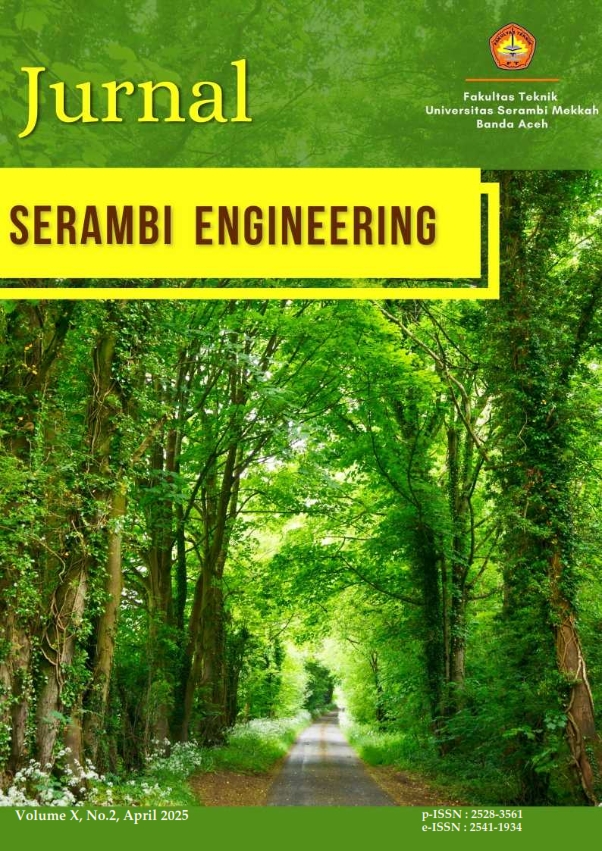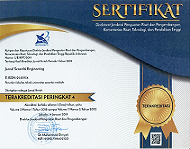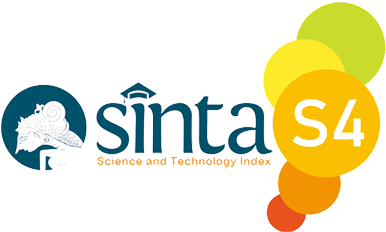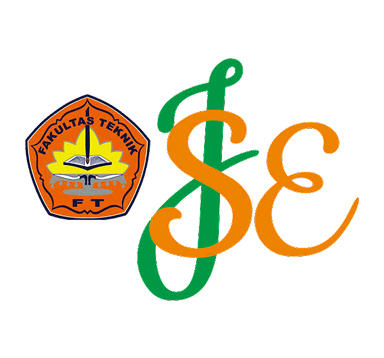Pengaruh Bahan Baku terhadap Karakteristik Produk Hasil Pirolisis: Studi Literatur
Keywords:
Bahan Bakar Alternatif, Biomassa, Energi Terbarukan, Limbah Plastik, PirolisisAbstract
The global climate change phenomenon is prompting initiatives aimed at transitioning energy sources towards more sustainable pathways. Pyrolysis technology offers significant potential in the conversion of biomass and plastic waste into alternative energy sources. The objective of this literature review is to analyze the effect of feedstock type on pyrolysis product characteristics and its potential as an energy source. The results of the literature study indicated that the feedstock from biomass possessed a lower calorific value in comparison to waste composed of polymer compounds. The pyrolysis process yields three primary byproducts: char, bio-oil, and gas. Char can be utilized as a solid fuel, such as briquettes. The processing of bio-oil into liquid fuel, bioethanol, is a viable option. The pyrolysis gas is a versatile material that can be utilized as a fuel for stoves and generators. Pyrolysis, a promising technology, has the potential to convert biomass and plastic waste into alternative energy. The type of feedstock employed is a critical factor in determining the quality and quantity of pyrolysis products. Through process optimization and technological development, pyrolysis has the potential to play a substantial role in reducing reliance on fossil fuels and addressing environmental concerns.
References
[1] J. Matheus, N. F. Delicia, and Rasji, “Implementation of the Carbon Tax Policy in Indonesia : Concepts and Challenges Towards Net Zero Emissions 2060,” vol. 7, pp. 91–114, 2023.
[2] A. Bramantya, S. Untari, and R. A. Mawarti, “Mewujudkan Net Zero Emission 2060 Melalui Konversi Sampah Menjadi Listrik dalam Perspektif Smart City,” J. Ilm. Muqoddimah J. Ilmu Sos. Polit. dan Hum., vol. 8, no. 1, p. 190, 2024, doi: 10.31604/jim.v8i1.2024.190-199.
[3] L. T. Hermawan and A. Prabhawati, “Implementasi Just Energy Transition Partnership Indonesia menuju Net Zero Emissions tahun 2060”, doi: 10.14710/jebt.2024.24161.
[4] R. P. Primadanty, “Potensi Biomassa Dalam Transisi Energi di Indonesia,” Parahyangan Econ. Dev. Rev., vol. 2, no. 2, pp. 136–143, 2023, doi: 10.26593/pedr.v2i2.7707.
[5] R. Hasibuan and H. M. Pardede, “Pengaruh Suhu dan Waktu Pirolisis terhadap Karakteristik Arang dari Tempurung Kelapa,” J. Tek. Kim. USU, vol. 12, no. 1, pp. 46–53, 2023, doi: 10.32734/jtk.v12i1.8534.
[6] S. Kadarwati, E. Apriliani, R. N. Annisa, and C. Kurniawan, “From Waste To Energy: Konversi Termal Limbah Pengolahan Kayu Menjadi Bio-Oil Melalui Teknik Pirolisis,” pp. 160–187, 2021, [Online]. Available: https://bookchapter.unnes.ac.id/index.php/PSDAI/article/view/6
[7] A. Aladin, B. Modding, T. Syarif, L. Wiyani, and H. A. Azis, Pirolisis Simultan. PT. Nas Media Indonesia, 2023.
[8] Z. Ulma, N. Faizin, R. F. Afiandi, T. E. Terbarukan, and P. N. Jember, “Analisis Mutu Briket Berbahan Baku Campuran Ampas Teh dan Sekam Padi Menggunakan Perekat Molase dengan Metode Pirolisis,” J. Sustain. Energy Dev., vol. 1, no. 1, pp. 35–40, 2023.
[9] S. A. Aviandharie, B. N. Jati, and R. Ermawati, “Pemanfaatan Gas Hasil Proses Pirolisis Plastik Polyethylene (PE) Sebagai Bahan Bakar dengan Metode Kondensor dan Metode Tangki Air,” J. Ris. Teknol. Ind., vol. 14, no. 1, pp. 88–96, 2020.
[10] Syamsudin, N. Gumelar, and Yuono, “Produksi Bio-oil dan Bio-arang dari Mata Kayu Industri Pulp melalui Pirolisis,” J. Ris. Ind. Has. Hutan, vol. 11, no. 1, pp. 2–5, 2019.
[11] Y. Yuniarti, E. Megawati, A. Dewi, D. Ariyani, M. R. Vegatama, and A. Sahara, “Pengaruh Suhu Terhadap Karakteristik Arang Hasil Pirolisis Kulit Kolang-Kaling (Arenga pinnata),” Distilat J. Teknol. Separasi, vol. 8, no. 4, pp. 1020–1030, 2023, doi: 10.33795/distilat.v8i4.410.
[12] J. A. Riandis, A. R. Setyawati, and A. S. Sanjaya, “Pengolahan Sampah Plastik Dengan Metode Pirolisis Menjadi Bahan Bakar Minyak,” J. Chemurg., vol. 5, no. 1, p. 8, 2021, doi: 10.30872/cmg.v5i1.4755.
[13] K. Ridhuan, D. Irawan, and R. Inthifawzi, “Proses Pembakaran Pirolisis dengan Jenis Biomassa dan Karakteristik Asap Cair yang Dihasilkan,” Turbo, vol. 8, no. 1, pp. 69–78, 2019.
[14] L. Li, J. S. Rowbotham, H. Christopher Greenwell, and P. W. Dyer, An Introduction to Pyrolysis and Catalytic Pyrolysis: Versatile Techniques for Biomass Conversion. 2013. doi: 10.1016/B978-0-444-53878-9.00009-6.
[15] Z. Arifah, S. Jamilatun, A. Rahayu, E. Astuti, and R. Sri, “Review : Biochar from Co-Pyrolysis of Biomass and Plastic,” vol. 1, no. 1, pp. 34–47, 2023.
[16] T. W. Widayati, D. Jaya, A. Danujatmiko, and B. D. Irimulyo, “Pirolisis Limbah Pangkal Bambu Betung (Dendracalmnus asper),” Pros. Semin. Nas. Tek. Kim. “Kejuangan,” pp. B8-1-B8-5, 2020.
[17] A. S. C. Pratama and K. Sa’diyah, “Pengaruh Jenis Biomassa Terhadap Karakteristik Asap Cair Melalui Metode Pirolisis,” DISTILAT J. Teknol. Separasi, vol. 8, no. 1, pp. 36–44, 2023, doi: 10.33795/distilat.v8i1.260.
[18] M. Raza et al., “Progress of The Pyrolyzer Reactors and Advanced Technologies for Biomass Pyrolysis Processing,” Sustain., vol. 13, no. 19, pp. 1–42, 2021, doi: 10.3390/su131911061.
[19] O. P. Bamboriya, L. S. Thakur, H. Parmar, A. K. Varma, and V. K. Hinge, “A Review on Mechanism and Factors Affecting Pyrolysis of Biomass,” Int. J. Res. Advent Technol., vol. 7, no. 3, pp. 1014–1024, 2019, [Online]. Available: www.ijrat.org
[20] B. B. Hoxha, B. H. Incorporated, and K. K. Sweeney, “Waste-To-Fuel Technology in Albania-Development System To Support an Active Drilling Industry,” no. May, 2018.
[21] D. S. Nawawi et al., “Karakteristik Kimia Biomassa untuk Energi,” Ilmu Teknol. Kayu Trop., vol. 16, no. 1, pp. 45–51, 2018.
[22] W. Adoe, Dominggus G.H. Bunganaen, I. F. Krisnawi, and F. A. Soekawanto, “Pirolisis Sampah Plastik PP (Polyprophylene) Menjadi Minyak Pirolisis sebagai Bahan Bakar Primer,” J. Tek. Mesin UNDANA, vol. 03, no. 01, pp. 17–26, 2016.
[23] R. Prakash, R. Siddharth, and N. Gunasekar, Cracking of Toxic Waste. Elsevier Ltd., 2018. doi: 10.1016/B978-0-08-102528-4.00010-9.
[24] S. Jamilatun, J. Pitoyo, Z. Arifah, S. Amelia, and A. Maarif, “Pirolisis Ampas Tebu ( Saccharum officinarum Linn ): Pengaruh Suhu terhadap Yield dan Karakteristik Produk,” Semin. Nas. Penelit. LPPM UMJ, pp. 1–11, 2022.
[25] A. A. Arahim, W. Widayat, and H. Hadiyanto, “Pengaruh Katalis Genteng Tanah Liat dalam Proses Produksi Bahan Bakar Cair dari Limbah Ban Bekas dengan Proses Pirolisis,” J. Energi Baru dan Terbarukan, vol. 1, no. 2, pp. 62–67, 2020, doi: 10.14710/jebt.2020.9909.
[26] S. Septarini, Z. Amni, and W. Amnia, “Pengolahan Limbah Organik Rumah Tangga Untuk Produksi Bio-Oil Sederhana,” Sci. J. Mech. Eng. Kinemat., vol. 8, no. 2, pp. 158–167, 2023, doi: 10.20527/sjmekinematika.v8i2.281.
[27] A. K. Varma, L. S. Thakur, R. Shankar, and P. Mondal, “Pyrolysis Of Wood Sawdust: Effects Of Process Parameters On Products Yield And Characterization Of Products,” Waste Manag., vol. 89, pp. 224–235, 2019, doi: 10.1016/j.wasman.2019.04.016.
[28] N. Fanani et al., “Konversi Plastik HDPE menjadi Fuel melalui Proses Pirolisis,” Semin. Teknol. Perencanaan, Perancangan, Lingkungan, dan Infrastruktur II FTSP ITATS, pp. 452–456, 2021.
[29] F. F. D. Hidayat and I. H. Siregar, “Uji Karakteristik Minyak Pirolisis Berbahan Baku Limbah Plastik Polypropylene,” J. Tek. Mesin, vol. 10, no. 01, pp. 13–20, 2022, [Online]. Available: https://ejournal.unesa.ac.id/index.php/jtm-unesa/article/view/43904
[30] D. Mustofa, S. Amatullah, D. Muhamad, and I. Susanto, “Characteristics of Liquid Co-Pyroliysis Products From Plastic Waste and Used Engine Oil,” vol. 23, no. 2, pp. 55–61, 2024.
[31] M. Jahiding, E. . Hasan, M. Mashuni, Y. Milen, and F. Ayuningsih, “Kinerja Coke-Hybrid Berbasis Tandan Kosong Kelapa Sawit dan Limbah Plastik Polypropylene yang Diproduksi dengan Metode Co-Pirolisis,” Indones. J. Pet. Miner., vol. 3, pp. 1–6, 2023.
[32] K. Ridhuan and D. Irawan, “Pengaruh Jenis Biomassa Terhadap Karakteristik Pembakaran dan Hasil Bioarang Asap Cair dari Proses Pirolisis,” J. Mech., vol. 10, no. 1, pp. 7–13, 2019.
[33] Hainur Aini, Puspita Rahayu, Alizar Ulianas, Egi Agustian, and Anny Sulaswatty, “Pengaruh Temperatur Pirolisis Terhadap Karakteristik Biochar dari Limbah Padat Agroindustri Teh,” INSOLOGI J. Sains dan Teknol., vol. 2, no. 6, pp. 1173–1183, 2023, doi: 10.55123/insologi.v2i6.3059.
[34] R. Jalil et al., “Physico-chemical and Energy Characteristic of Charcoal Derived from Two (Different) Sarawak Wild Bamboo Species,” J. Chem. Eng. Ind. Biotechnol., vol. 8, no. 2, pp. 26–35, 2022, doi: 10.15282/jceib.v8i2.8771.
[35] M. Fatimura, R. Sepriyanti, and R. Yunita, “Pengolahan Limbah Plastik Jenis Kantong Kresek Dan Gelas Minuman Menggunakan Proses Pirolisis Menjadi Bahan Bakar Minyak,” J. Redoks, vol. 4, no. 2, p. 41, 2019, doi: 10.31851/redoks.v4i2.3509.
Downloads
Published
Issue
Section
License
Copyright (c) 2025 Sheila Novella Arvenia, Mohamad Rangga Sururi, Novi Fitria (Author)

This work is licensed under a Creative Commons Attribution 4.0 International License.













